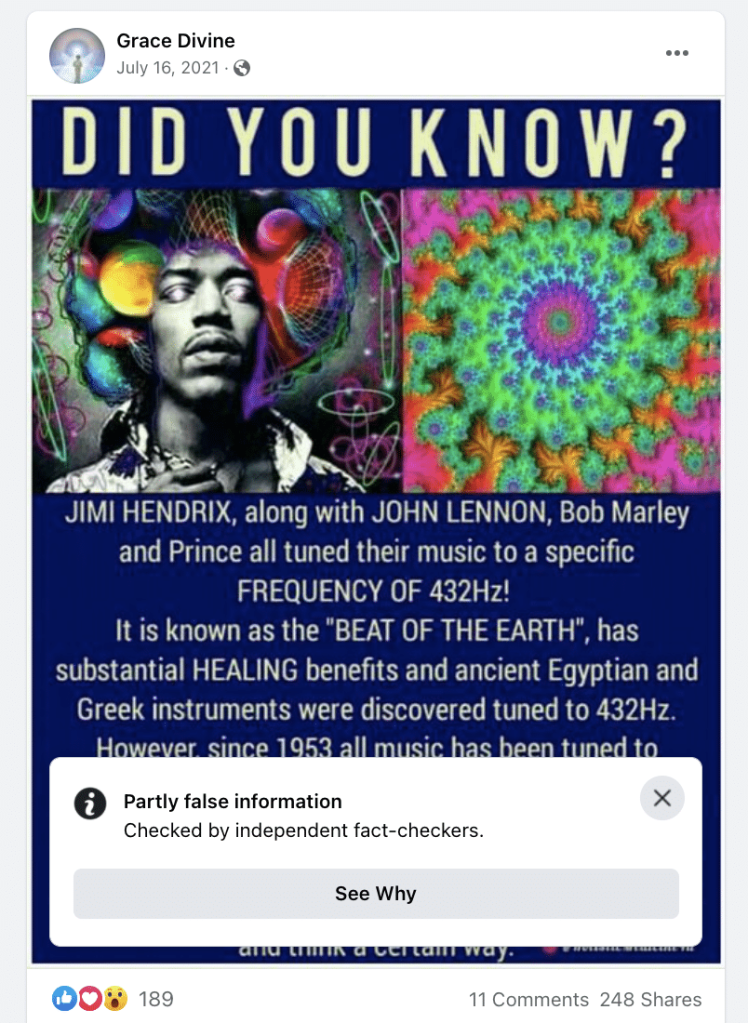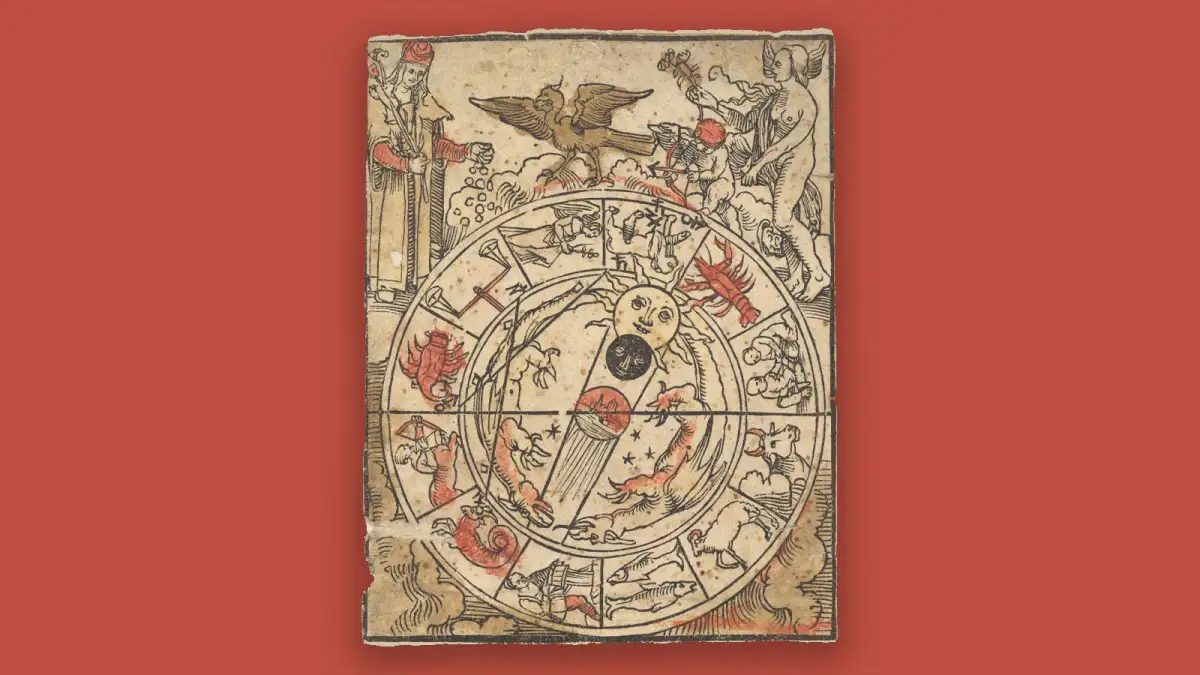“I’ve been interested in the 432 Hz conspiracy theories for a while,” began an email from my editor at VAN. “Would you like to spend some time using the 432 Player, a website that adjusts all your music to 432 Hz?”
I consider myself a very online person, and yet, through a mixture of willful ignorance, immediate distrust of poor graphic design, and YouTube algorithms utterly determined to show me every single one of Frank Lampard’s best corners, I’d never encountered the 432 Hz phenomenon. Its lore has all the hallmarks of your archetypal conspiracy theories. No one version dominates, but most accounts include a selection of the following tropes:
Tuning to A=440 Hz is:
- Evil
- A lie
- Something that was promoted by the Nazis to brainwash the masses
- Not in tune with the rhythm of the universe
- Capable of unleashing inner turmoil
- Coordinated by a nefarious cabal of businessmen
Tuning to A=432 Hz is:
- Beautiful
- Spiritual
- Peaceful
- Historically legitimate
- Full of healing powers
- Capable of aligning the chakras
- What Verdi would have wanted
“Did you know that JIMI HENDRIX, along with JOHN LENNON, Bob Marley and Prince all tuned their music to a specific FREQUENCY OF 432Hz!” reads a much-shared social media post. Both the proto-astral design and its rAnDoM CaPiTaLiZaTiOn suggest its links to the Expanding Brain genus of memes, but Reuters decided to do a full and frank fact check on it anyway, in a lengthy article that featured tenured music professors expressing their opinions on said meme.

What piqued my interest most about the Reuters report was the contribution from Berklee College of Music professor and Grammy-winning producer/engineer Prince Charles Alexander, who claimed that “most listeners’ sensibilities are not fine-tuned enough to discern the difference” between 432 Hz and 440 Hz. In a situation as annoying for my friends as it is useful for me, I have perfect pitch, which means—at least in this case—I’m not most listeners. What could be the effects of extended spans of enforced exposure to music outside of my comfort zone? Might this be the long-awaited sorting out of the chakras I’ve been dreaming of? At the very least, would fundamentally recalibrating my listening make for good content?
Reader, I obviously said “yes.”

With a logo like a child’s Christmas morning spirograph creation, the 432 Player introduces A=432 Hz as the “Mathematical Tuning,” the “Natural Tuning,” and “the Pythagorean tuning.” Just in case that isn’t comprehensive enough for the discerning New Age consumer, its creators laud the frequency, which “resembles a code underlying our very universe in all aspects—light, time magnetism, DNA, [and] sacred geometry.”
As you might expect, the all-encompassing philosophy doesn’t restrict itself to a single platform. In fact, the 432 Family is made up of five apps: a radio app, an instrument tuner, something called Cymascope (whose uses range from biology and botany to asteroseismology, ornithology and—get this—musicology), and an album called Dreamworld by the app’s creator, Ophir Paz. All roads eventually lead back to the 432 Player, even a recent visual comparison between an “unretouched cymatic” and a tomato.
In support of his arguments, Paz cites Maria Renold and her “stunning conclusion” that over 90% of all the people to whom she played music at 432Hz preferred it. A quick check of Renold’s credentials doesn’t lead to a series of publications on JStor or even a Wikipedia entry. It does, however, lead to an NFT that uses her “Scale of Fifths” tuning method to graft vaguely primordial buzzes onto an otherwise generic tech-house track. The company’s introduction to the player concludes with a quote from Albert Einstein that I’m unable to trace to any sites outside of the New Age bubble. Interestingly, those sites also regularly attribute the same quote to Nikola Tesla. I guess we really are all one.
It’s worth nothing that A=432 has garnered support from legitimate musicians, whether or not their reasons were legitimate. Carlo Bergonzi was among those staunchly supportive of a move to 432 Hz. “The tuning is ideal for voices, because Verdi wrote for the registral passage. If the tuning is raised higher, this passaggio is moved around,” he said in a frankly wild interview with the Schiller Institute in 1993. He cites Verdi’s letter from 1884, a sacred text among 432-ers that “this A must be the A for opera,” before channeling Helen Lovejoy: “It’s our young people who are at stake” Bergonzi cries, bravely defending future generations from those devilish sharper tones.
As it turns out, the 432 Player is a technological response to something that’s been happening for years. Since the days of Napster and Kazaa, listeners have ripped music from the internet, adjusted the pitch, and reposted it. To discover just how much music has had this treatment, type your favorite artist into the YouTube search bar followed by “432.” But what both the bootleg and formal platforms miss is the entire point of the exercise: If listeners have a problem with the imposition of equal temperament as a default standard at the expense of other temperaments—as has been expressed many times—surely the solution comes by completely reimagining western harmony and its intervals, rather than holding on to equal temperament and just sliding everything down a bit?
The latest from VAN, delivered straight to your inbox
That tension between supposedly scientific arguments and brain-melting stupidity is another factor in ensuring 432 Hz’s place in the pantheon of classic internet conspiracy theories. One blog post from the Global Freedom Movement founder Brendan D. Murphy, titled “432 DNA Tuning and the Nazi-ization of Music,” begins in typical “wake up, sheeple” style: An evil Illuminati-style group has been controlling our minds in a “frequency war,” etc. Yet, despite his pretense of rejecting authority, Murphy finds no way of justifying his claims other than via overinflated appeals to authority and academic rigor. That creates wonderful, rake-treading sentences; like this one, which begins: “According to preliminary research, analysis, and professional discussions by Walton, Koehler, Reid, et al., on the web, A=440 Hz frequency music conflicts with human energy centers (i.e., chakras)…”
Anyway, perhaps because of their principled rejection of shadowy institutions, 432 Player is incompatible with Spotify. And so, with no music stored on my laptop and away from my usual working desk, I surrendered myself to the lottery of international digital radio at 432 Hz. Here’s my diary of how it went.
Session 1: BBC Radio 3
I decide to ease myself in gently. Radio 3 has been a reassuringly stable presence for many listeners (including myself) over the past two years. Surely Petroc Trelawny is impervious to the allure of 432 Hz?
It doesn’t get off to a great start. First up is the “Tielman Susato Suite,” arranged by trumpeter Crispian Steele-Perkins and performed by the London Gabrieli Brass Ensemble. In music already performed at baroque pitch, the gut reaction is that it feels even lower. Susato’s battaglia goes from regal and stoic to farty and annoyed, like a Monty Python gag stretched to the length of a Stewart Lee routine.
It’s intriguing to hear something as florid as Liszt’s “Valse-Impromptu” skipping along while sounding so determinedly mellow. The same can’t be said for José Carreras, who just sounds sad. Poulenc ends up sounding like Korngold.
Jussi Björling and Robert Merrill’s rendition of the famous duet “Au fond du temple saint” from Bizet’s “Les pêcheurs de perles” fares better, though it’s tainted by the memory of Björling’s support of 432 in the name of protecting bel canto singing; an act which opened the floodgates for all kinds of wild and wacky approaches to pitch. With that in mind, I switch stations.
Session 2: Easy Listening
Here’s a game you can play to ease the tedium of smooth jazz:
- Open 432 Player.
- Find yourself a smooth jazz radio station (I chose America’s finest, 101SmoothJazz.com).
- Select a track (George Jinda’s evergreen “Just My Imagination” was my pick).
- Every sixteen bars, use the toggle in the bottom right-hand corner of the browser to fluctuate between 432 and 528 Hz.
- Congratulations! You just created a New Age version of Miles Davis’s “So What.”
Notwithstanding that the 528 button defeats the entire point of 432 Player, it’s quite reassuring that there isn’t something magical that I’m missing by suddenly tuning smooth jazz downwards. It sounds just as dreary in either frequency.
Session 3: Stuff with Guitars
Joni Mitchell’s “California” flashes up on the screen as I tune into Radio Paradise California, reminding me that it’s been a while since I’ve sat alone in my room and cried along to the entirety of “Blue.” It’s also where the first snag in 432 Player’s mostly passable interface occurs. It can’t quite handle Radio Paradise’s processing rate; cutting out, jumping back in, and changing speed so much that the auditory experience is like listening to vinyl on a turntable made of jelly. After eventually growing accustomed to this wobbly state, my mind wanders and hopes—prays, even—that, in rejecting Spotify, Mitchell doesn’t contemplate embracing the 432 lifestyle to fill the void.
Many times during this experiment I feel a confused liminality caused by listening too hard to stations that aren’t really designed to be listened to at all. As I switch channels to something smoother, and as Joni moves into Sting, Karen O, and others, I do genuinely wonder if my brain is turning to soup; if, by giving this phenomenon too much of a sideways look, my brain might pour out of my ears. I decide to give radio a rest for a while.
Session 4: The Best of Verdi (432Hz)
It’s time for something else. So I log out of 432 Player, turn to YouTube, and, naturally, stick on “The Best of Verdi (432Hz)”.
The 432 lobby’s obsession with Verdi peaked when convicted criminal, cult leader, and sometime opera fan Lyndon LaRouche booked Washington’s Lisner Auditorium in May 1989, for a gala concert in support of his Schiller Institute’s international campaign to lower tuning pitch to A=432. This campaign, in turn, was based on a historically-contentious claim that Verdi had deep concerns about fluctuations in pitch. It gained high-profile encouragement: In addition to Bergonzi and Björling, Montserrat Caballé, Renata Tebaldi, and Luciano Pavarotti all expressed their support for the campaign.
The presence of even one of those figures still wouldn’t be able to improve this live recording, which is utterly awful even without the supposedly redeeming fidelity to the composers’ intentions. The Best of Verdi (432Hz) is four and a half hours of my life that I will not be getting back. Si, vendetta. Tremenda vendetta.
Session 5: Classic FM
The following morning, I tune in to Classic FM. The home of inane waffle—Bill Turnbull’s searing, timely intervention on the “hot versus cold custard” debate being my recent favorite—and exorbitant audio compression. What little audio quality is left doesn’t suffer under 432 Hz. In between adverts for dentures and life insurance, “Danse Macabre” retains some of its fierceness, Lehár’s “Merry Widow” still sounds jolly, the twinkly sound world of Debbie Wiseman’s “The Glorious Garden” remains undeterred, and Charles Mackerras’s Beethoven 6 verges on sounding quite good—maybe even better than before?
It’s at this point that the dark thoughts creep in. Has it finally got me? Is this the end? Do I now have to know about cartomancy, Scorpio season, and Mercury retrograde?
Session 6: Normal Life
I close 432 Player, turn the radio on, and simultaneously tune in and out of music at 440 Hz.
Try as I might, 432 Hz failed to make me happier, more balanced, or less anxious. My chakras remain frustratingly misaligned; my third eye more Wotan than Argus. The scar on my elbow from a bike accident remains mysteriously unhealed. Of all the legitimate forms of music therapy, this isn’t it. Nothing has changed, everything is as it was. Although…
I do wish I had a pitch shift button. In life, generally, to make things immeasurably funnier with just one click. And if 432 Player has one redeeming feature, it’s that button. Though it does defeat the entire premise of the theory.
Anybody for an A=528 Hz conspiracy instead? ¶
Subscribers keep VAN running!
VAN is proud to be an independent classical music magazine thanks to our subscribers. For just over 10 cents a day, you can enjoy unlimited access to over 875 articles in our archives—and get new ones delivered straight to your inbox each week.
Not ready to commit to a full year?
You can test-drive VAN for one month for the price of a coffee.


